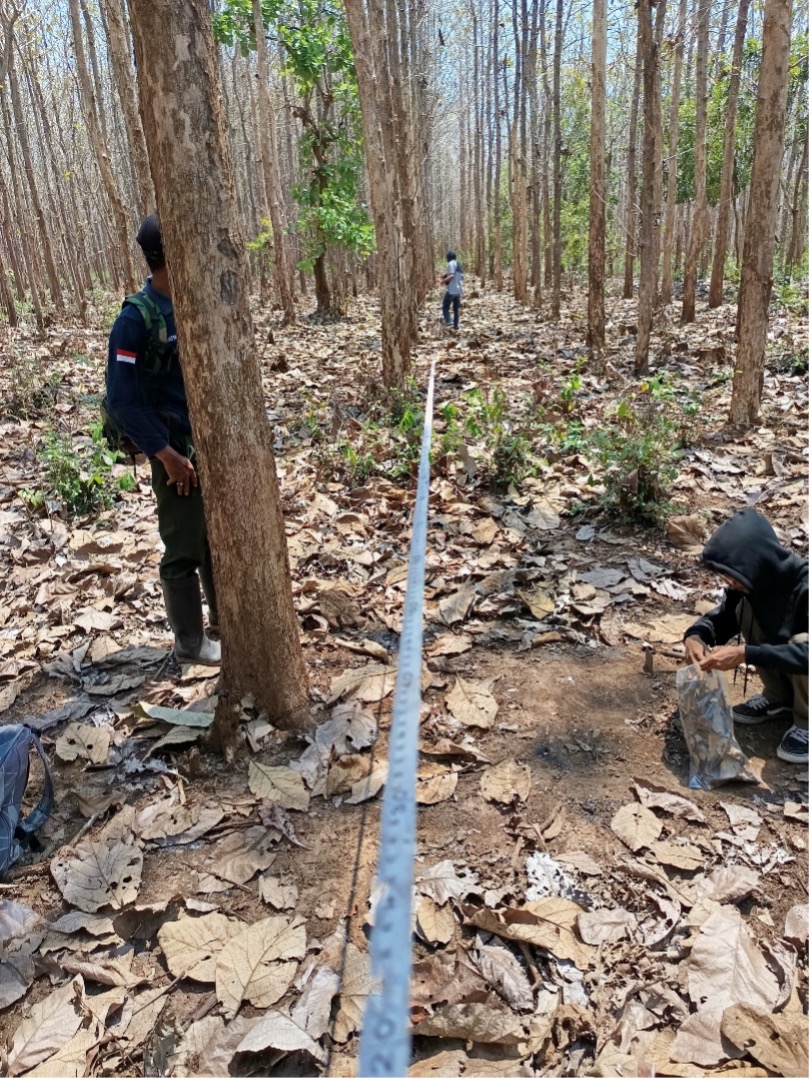admin
26 March 2025 - 10:25 WIB
0
Fahmi Herwinastwan, a master’s student at The Department of Soil Science, shared his experience during his sampling. He studies carbon stock in the BKPH Bandung, KPH Purwodadi, Central Java.
As part of the carbon stock study, soil and biomass samples were collected from several forest plots within the working area of the Forest Area Stabilization Center (Balai Pemantapan Kawasan Hutan, BPKH) Bandung, under the Forest Management Unit (Kesatuan Pemangkuan Hutan, KPH) Purwodadi, Central Java. The research locations were spread across six plots: Plot 55, 36, 37, 38, 39, and 44. The primary objective of this study was to understand the dynamics of carbon stock in forest ecosystems through an analytical approach to soil, stand biomass, and litter. This research aimed to obtain data supporting forest management strategies focused on climate change mitigation.
The collected soil samples were taken from a 0–30 cm depth, representing the active zone for organic matter decomposition and root interactions. The sampling was conducted using the composite method, where multiple sub-samples from different points within a plot were combined to provide a more representative overview of soil conditions at the research sites. These soil samples were later analyzed to determine soil organic carbon (SOC) content, soil texture, and other chemical parameters related to carbon storage capacity. Soil organic carbon content is one of the key indicators in assessing a forest's potential as a carbon sink from the atmosphere.
In addition to soil analysis, the study also focused on measuring stand biomass as one of the primary components of carbon storage. Data collection was conducted within 20 × 20-meter plots at each research location. Observed parameters included the number of tree individuals, diameter at breast height (DBH), and wet weight of the stands. DBH measurements were taken at a height of 1.3 meters above ground level using a diameter tape. The data obtained from these measurements were converted into total biomass using appropriate allometric equations for each plant species.
The plant species examined in this study included Red Calliandra (Calliandra calothyrsus), Gliricidia (Gliricidia sepium), and Teak (Tectona grandis). These plants were categorized into three age groups: less than 5 years old, less than 10 years old, and more than 10 years old. The age differences in the stands significantly influenced biomass accumulation and carbon sequestration levels, with older stands having a greater carbon storage potential.
Litter samples were collected within 2 × 2-meter plots. The collected litter included various organic materials that had fallen to the forest floor, such as leaves, small twigs, and other plant parts. The primary parameter observed was wet weight, which was later dried in a laboratory to obtain dry weight as the basis for calculating carbon content. Litter plays a crucial role in the forest carbon cycle, as it is the main source of organic matter undergoing decomposition and contributes to soil carbon content.
During the sampling process, the research team was accompanied by Forestry Assistants responsible for each research plot. This assistance was essential to ensure that sampling procedures were conducted following operational standards while considering technical aspects and field safety. Additionally, collaboration with Perhutani officials helped the researcher understand the historical conditions and forest management practices at the research sites, which could be crucial factors in data analysis.
This study is expected to provide a more comprehensive understanding of carbon stock in forest ecosystems through a holistic approach, encompassing soil, stand biomass, and litter. The obtained data can be used to support forest conservation efforts and sustainable forest resource management policies. Furthermore, the findings from this study could contribute to forest carbon reserve calculations relevant to climate change mitigation schemes, such as REDD+ (Reducing Emissions from Deforestation and Forest Degradation). By understanding carbon stock across various forest components, this research also aims to provide valuable scientific information for forest management in Indonesia, particularly in enhancing the role of forests as carbon sinks in addressing global climate change challenges.
 EN
EN ID
ID

